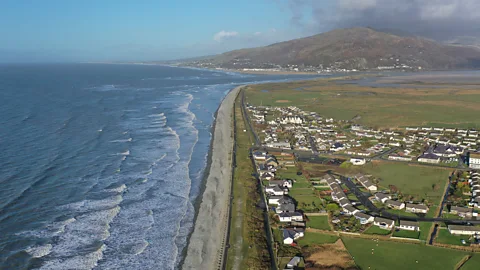The UK 'climate refugees' who won't leave
 Getty Images
Getty ImagesThe Welsh village of Fairbourne is at high risk of being submerged from rising sea levels and residents have been told they will need to move. But many say they will refuse to leave.
Gazing out across the glistening ocean as his dog Lucy races along the beach, 72-year-old Stuart Eaves says there is nowhere else in the world he would want to live.
Eaves has lived in Fairbourne, a tiny Welsh village nestled between Snowdonia National Park and the Irish Sea, for 26 years. He knows everyone in the 700-strong community. He runs the local campsite, and raised his five children here.
"It's such a lovely place to live. There's not a lot of money here but it's got what money can't buy: peace, tranquillity, security and community," he says.
But all of that is under threat; Fairbourne is facing an existential crisis. The tiny village has been identified as being at high risk of future flooding because of climate change, with residents told it is beyond saving.
In 2014, Gywnedd Council, which has oversight of Fairbourne, said it would not maintain flood defences indefinitely and that from 2054 the village will no longer be inhabitable. The council plans to "decommission" the entire village, dismantling all homes, roads, shops and infrastructure, and turn it back into marshland.
But Fairbourne residents are refusing to accept that their community is lost to the sea and are furious they have not received any compensation or assistance from the council. Climate experts say that other coastal communities in the UK face a similar fate and that the government must put plans in place to people who are forced to move because of climate impacts. Some argue the UK could emulate models of flood management from other countries, such as the Netherlands, which has been battling rising water for centuries and has devised a novel approach to tackling the issue.
It's a question that faces communities all over the world, with hundreds of millions of people facing displacement due to climate impacts by 2050. Finding solutions to help people with losing their homes is becoming an imperative of our age.
 Getty Images
Getty ImagesLow-lying Fairbourne is vulnerable to flooding from multiple sources: the sea, a nearby estuary and river run-off flowing down from the hills. The flood risk is projected to increase drastically over the next 30 years.
"The latest forecasts predict that it would not be safe or sustainable to defend Fairbourne beyond 2054," says a spokesperson for Gwynedd Council. They attribute this to several factors: accelerating sea level rise, an increased likelihood of severe storms caused by climate change, and the unique geological conditions surrounding the village.
Five years ago, Natural Resources Wales (NRW), the organisation responsible for flood management in Wales, spent £6.8m ($8.8m) on strengthening 1.8 miles (2.9km) of concrete tidal defences to protect more than 400 properties in Fairbourne from storm surges and flooding, and to rebuild the outfalls, where the water drains, of the rivers Henddol and Morfa. Defending Fairbourne from flooding requires constant maintenance, with annual costs totalling around £19,000 ($24,000), according to NRW.
"We are fighting nature to provide a level of protection for people," says Sian Williams, head of operations in North Wales for NRW.
You might also like:
Fairbourne's first line of defence from the ocean is a shingle bank made of small, round pebbles which has formed naturally since the end of the last ice age 14,000 years ago.
But these defences will not hold back the water forever. Big storms and high tides are eroding the shingle bank, leaving residents exposed to the sea, says Williams. By 2054, sea levels are projected to rise by over 1m (3.3ft) under a worst-case scenario. "2054 is the tipping point when the cost-benefit no longer stacks up to maintain the flood protection systems," says Williams.
From 2054, the costs of maintaining the flood defences, estimated at £115m ($142m) over the next 100 years by the council, exceed the economic benefits (namely the value of properties) which the council estimates at £70m ($87m).
The villagers are furious at the proposal to abandon the village and have refused to accept that they will be forced to leave behind their homes and community. The council's decision "has destroyed people's lives and livelihoods", says Eaves. "It's devastating."
Fairbourne's residents are not only fearful of losing their homes and jobs. They say the council's decision also threatens their way of life and community values.
"People here have no fears, we go for a walk when it's dark and don't lock our doors," says Eaves. "Everyone knows each other and talks to each other. If we have to move, we've got to abandon this way of life and learn to live in a new way. It's more than just losing your home; it's losing your whole identity."
 Isabelle Gerretsen
Isabelle GerretsenBut could there be other options for Fairbourne? In some parts of the UK, communities are taking matters into their own hands due to inadequate government measures to protect them from flooding.
Villagers in Lancashire built their own £100,000 ($125,000) flood defences after they were initially refused government aid in 2016. They made the decision after 100 properties were badly flooded in Churchtown and two neighbouring villages in 2015 following heavy rainfall.
When the council told them that they didn't qualify for funding, Churchtown residents raised £30,000 ($37,000) to build a clay and brick embankment, designed by local farmers. The Environment Agency then provided the remaining £70,000, saying the embankment was the UK's only resident-built flood relief scheme.
The embankment, which is maintained by residents, held and kept all houses dry when storms Ciara and Dennis hit Churchtown in 2019, says Siriol Hogg, the founder of the Churchtown Flood Action Group. Hogg had to leave her home for 15 months after it flooded in 2015. "It was terribly distressing," she says, noting the experience forced her to seek medical for anxiety. "The people of Fairbourne must be under such mental strain and feeling such grief."
Along with other Fairbourne residents, Eaves put forward a proposal last month to Gwynedd Council for the construction of 100 tetrapods – four-legged concrete structures that are used to dissipate the force of incoming waves and prevent coastal erosion. They estimate that it will cost around £50,000 (£62,500). Tetrapods are widely used as coastal defences in Japan. "It would extend the life of the village quite dramatically," says Eaves.
Installing the tetrapods will be like "creating an artificial reef," says Angela Thomas, clerk of the community council. "They will take the sting out of waves coming in."
Thomas says the cost of constructing tetrapods is a "drop in the ocean" compared to the planned spending to dismantle Fairbourne, which could cost an estimated £27m ($34m), according to a demolition and site clearance budget, drawn up by Ultimate Engineering Solutions and seen by BBC Future. "Why is that money not spent on defending Fairbourne">window._taboola = window._taboola || []; _taboola.push({ mode: 'alternating-thumbnails-a', container: 'taboola-below-article', placement: 'Below Article', target_type: 'mix' });
